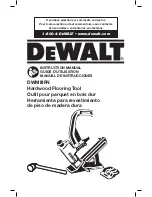
5- ENG
Operating Pressure
70 to 90 p.s.i.g. (4.9 to 6.3 kg/cm
2
). Select the operating pressure within this
range for best fastener performance.
DO NOT EXCEED THIS RECOMMENDED
OPERATING PRESSURE.
Air Consumption
The DWMIIIFN requires 4.2 cubic feet per minute (221 liters per minute) of free air to
operate at the rate of 60 fasteners per minute, at 80 p.s.i. (5.6 kg/cm
2
). Take the actual
rate at which the tool will be run to determine the amount of air required. For instance,
if your fastener usage averages 30 fasteners per minute, you need 50% of the tool’s
c.f.m. of free air which is required to operate the tool at 60 fasteners per minute.
OPERATION
Air Supply and Connections
WARNING: Do not use oxygen, combustible gases, or bottled gases as a
power source for this tool as tool may explode, possibly causing injury.
FITTINGS
Install a male plug on the tool which is free flowing and which will release air pressure
from the tool when disconnected from the supply source.
HOSES
Air hoses should have a minimum of 150 p.s.i. (10.6 kg/cm
2
) working pressure rating
or 150 percent of the maximum pressure that could be produced in the air system.
The supply hose should contain a fitting that will provide “quick disconnecting” from
the male plug on the tool.
SUPPLY SOURCE
Use only clean regulated compressed air as a power source for this tool.
NEVER
USE OXYGEN, COMBUSTIBLE GASES, OR BOTTLED GASES, AS A POWER
SOURCE FOR THIS TOOL AS TOOL MAY EXPLODE.
REGULATOR
A pressure regulator with an operating pressure of 0 - 125 p.s.i. (0 - 8.79 kg/cm
2
)
is required to control the operat iing pressure for safe operation of this tool. Do not
connect this tool to air pressure which can potentially exceed 200 p.s.i. (14 kg/cm
2
) as
tool may fracture or burst, possibly causing injury.
OPERATING PRESSURE
Do not exceed recommended maximum operating pressure as tool wear will be greatly
increased. The air supply must be capable of maintaining the operating pressure at the
tool. Pressure drops in the air supply can reduce the tool’s driving power. Refer to
Tool
Specifications
for setting the correct operating pressure for the tool.
FILTER
Dirt and water in the air supply are major causes of wear in pneumatic tools. A filter will
help to get the best performance and minimum wear from the tool. The filter must have
adequate flow capacity for the specific installation. The filter has to be kept clean to
be effective in providing clean compressed air to the tool. Consult the manufacturer’s
instructions on proper maintenance of your filter. A dirty and clogged filter will cause a
pressure drop which will reduce the tool’s performance.




























